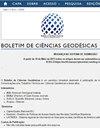基于与重力测量相关的水准的BVRF段之间的物理连接
IF 0.5
Q3 Earth and Planetary Sciences
引用次数: 1
摘要
摘要考虑到建立与位势空间相连的全球参考系统的努力,寻求新的替代方案来解决在经典的国家垂直网络中发现的问题。由于传统水准测量的地形困难,巴西垂直基准架(BVRF)分为两个不同的区段,具有独立的基准(Imbituba和Santana验潮仪)。2018年BVRF在位势空间的实现仍然没有其各部分之间的互操作性。我们根据国际大地测量协会(IAG)关于位势空间的新规定,分析了物理连接的替代方案。提出了一些基于GPS水准测量和重力测量相结合的物理连接解决方案。开发这些解决方案的目的是证明两个BVRF段之间的差异,现在根据位势数和正常高度进行。结果表明,根据所采用的策略,两个片段之间的差异在约45cm至140cm的范围内。与以前基于间接策略并涉及以前BVRF实现的确定进行了比较。本文章由计算机程序翻译,如有差异,请以英文原文为准。
PHYSICAL CONNECTION BETWEEN BVRF SEGMENTS BASED ON LEVELING ASSOCIATED WITH GRAVIMETRY
Abstract Considering the efforts to establish Global Reference Systems linked to the geopotential space, new alternatives are sought to address the problems found in the classic national vertical networks. The Brazilian Vertical Reference Frame (BVRF) was materialized in two different segments with independent datums (Imbituba and Santana tide gauges) due to the terrain difficulties for conventional leveling. The 2018 BVRF realization, in the geopotential space, still remains without interoperability between its segments. We analyze alternatives for physical connection based on the new precepts of the International Association of Geodesy (IAG) involving the geopotential space. Some proposed solutions for physical connection based on GPS leveling associated with gravimetry are presented. These solutions were developed with the aim of evidencing the discrepancy between the two BVRF segments, now carried out in terms of geopotential numbers and normal heights. The results indicate differences ranging from about 45 cm to 140 cm between the two segments depending on the strategy employed. Comparisons with previous determinations based on indirect strategies and involving previous BVRF realizations are made.
求助全文
通过发布文献求助,成功后即可免费获取论文全文。
去求助
来源期刊

Boletim De Ciencias Geodesicas
Earth and Planetary Sciences-General Earth and Planetary Sciences
CiteScore
1.70
自引率
20.00%
发文量
10
审稿时长
3 months
期刊介绍:
The Boletim de Ciências Geodésicas publishes original papers in the area of Geodetic Sciences and correlated ones (Geodesy, Photogrammetry and Remote Sensing, Cartography and Geographic Information Systems).
Submitted articles must be unpublished, and should not be under consideration for publication in any other journal. Previous publication of the paper in conference proceedings would not violate the originality requirements. Articles must be written preferably in English language.
 求助内容:
求助内容: 应助结果提醒方式:
应助结果提醒方式:


